|
|
Post by nuuumannn on Jun 22, 2014 22:18:02 GMT 12
Since I was not able to find any thread on the displays in the excellent RNZN Museum in this forum, Here are some pictures of some of the things on display within. I was also surprised to read that there were forum members who were unaware there was a navy museum in New Zealand. The museum is well worth going along for a visit and the cafe is superb, with a terrific view over the harbour. Here is a link to the museum's website: www.navymuseum.co.nz/ Previously located in a small building at Spring Street near the entrance to HMNZS Philomel, or Devonport Naval base, the museum has since moved to Torpedo Bay, which has a significant history in itself. Here's a link to the navy museum's website with more information - saves me copying what's already written: www.navymuseum.co.nz/about-usThe pictures here were taken both at the Spring Street location and at Torpedo Bay. In the entrance to the foyer of the museum is a memorial to HMS Neptune, with a nice model adorned with 150 sea men around her deck. these, of course represent those who lost their lives aboard the ship. The model:  A painting of a spar torpedo boat in action - a rather hazardous means of attacking an enemy vessel. Because of the Russian 'scare' earlier in the decade of the 1880s, four of these were constructed by John I. Thornycroft in 1883 for harbour defence and stationed at Lyttelton, Port Chalmers, Auckland and Wellington and were numbered consecutively as No.168 to 171. Their primary weapon was the spar fitted with explosive at its tip, hence its name, although the last two were equipped with Whitehead locomotive torpedoes. Obsolete by the time they reached New Zealand, the boats couldn't handle anything but a calm sea state owing to their shallow draught and were retired in 1901 - 1902. The remains of the Lyttelton boat are on display in the old magazine on the Lyttelton foreshore.  The 3rd Class light cruiser HMS Philomel was lent to New Zealand in 1913 as a training vessel to form the fledgling New Zealand Division. Active during WW1, the ship escorted troop vessels to German held Samoa and later one of the Anzac convoys to Egypt. She saw active service in the Eastern Mediterranean against the Turks before returning to New Zealand in 1917 and owing to her obsolescence, she was disarmed and led the rest of her life as a depot vessel, then a full time accommodation hulk with makeshift huts constructed on her deck. She was towed out off Cuvier Island and sunk in 1946. 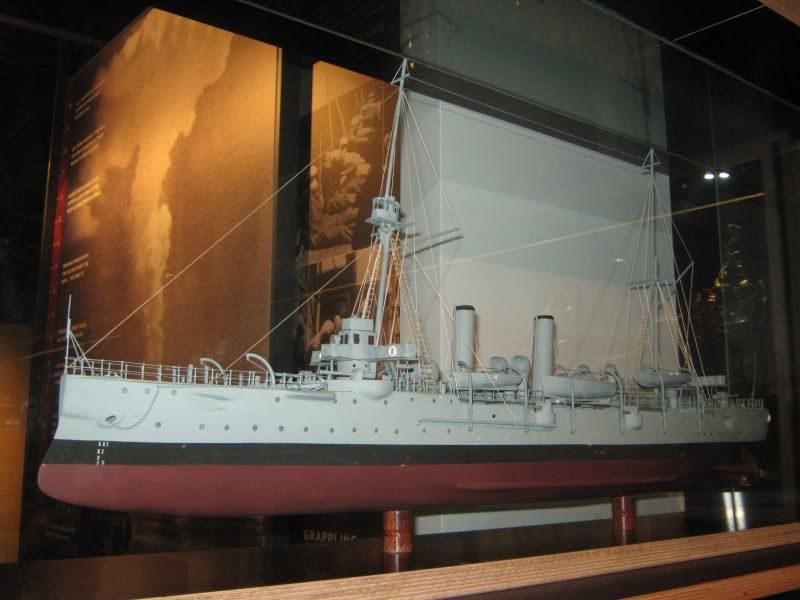  By far the largest and most powerfully armed naval vessel to have been borne from our coffers, HMS New Zealand was an Indefatigable Class battlecruiser armed with eight 12-inch guns in four turrets. Paid for by the Dominion, she was handed over for service in the Royal Navy on completion and visited New Zealand only twice, once in 1913 and again post war in 1919, where it is believed that, based on the numbers of visitors that went aboard at the ports she stopped in, around half the population got to see her. A flawed vessel because of the typical weaknesses of the class of ship, New Zealand served with the 1st Battlecruiser Squadron under Vice Admiral David Beatty during the first half of WW1 and saw much action with battle honours at Heligoland Bight, Dogger Bank and Jutland. As a direct result of the Washington naval arms limitation treaty of 1922, she was sold and scrapped a year later. Her 4-inch guns came to New Zealand and served as coastal batteries at Fort Dorset and Godley Head. Two of them survive outside the Auckland War Memorial Museum. 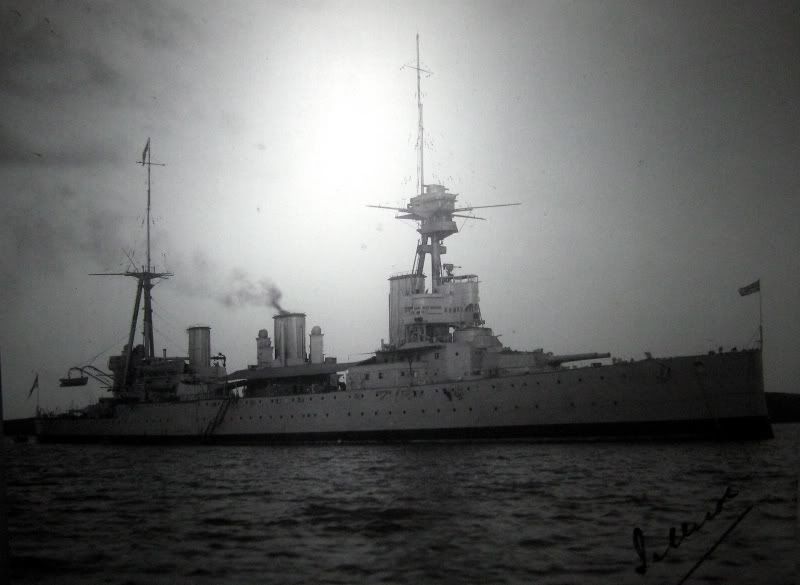  The museum holds a significant amount of ephemera related to the New Zealand, including furniture and silverware that she carried aboard, as well as her deck name plate and ship's bell: 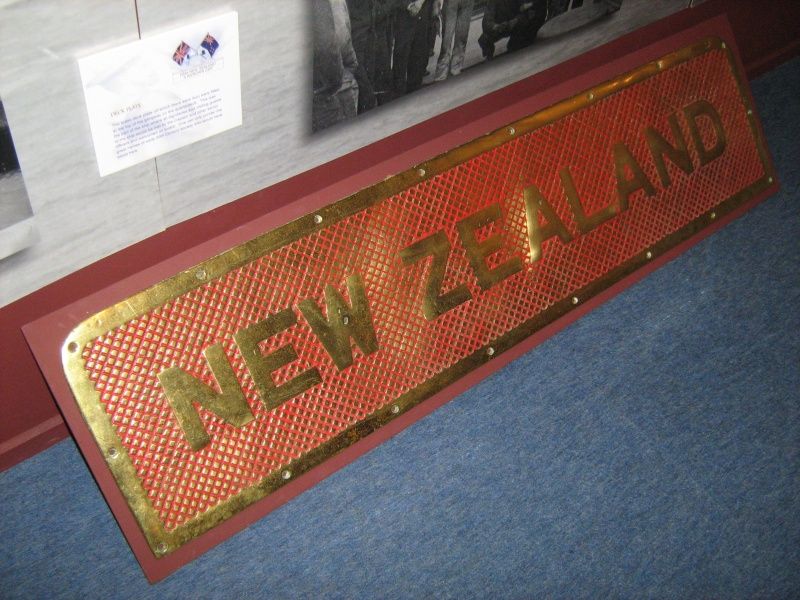 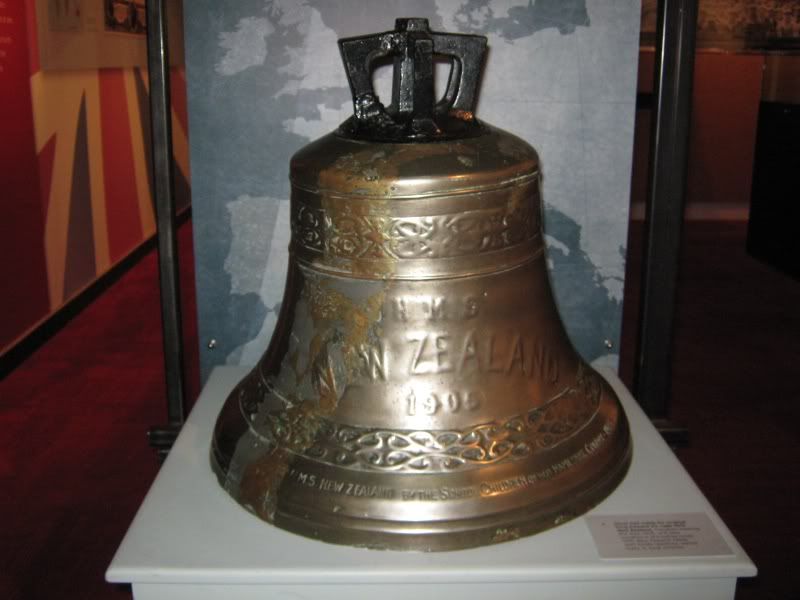 A painting depicting the ship in her home waters of the Firth of Forth, north of Edinburgh, Scotland where she was based at Rosyth. The enormous Forth rail bridge can be seen behind. 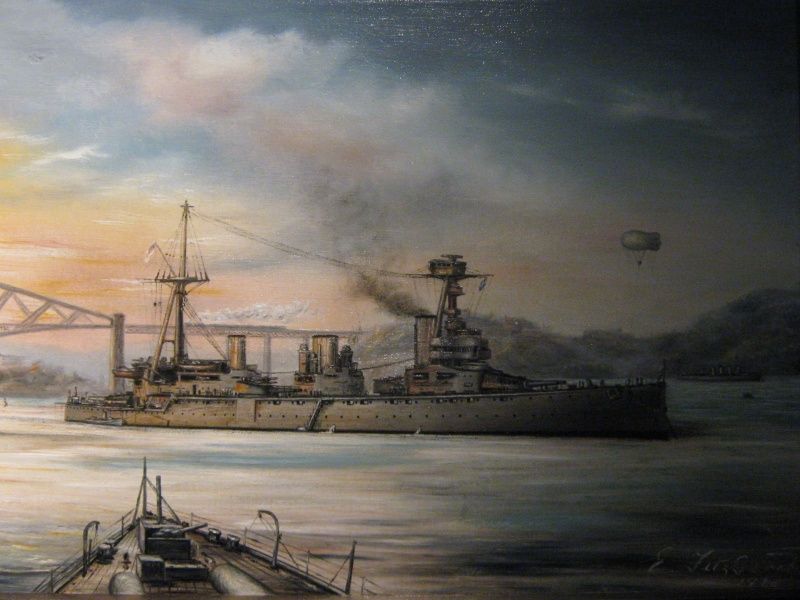 More to come. |
|
|
|
Post by nuuumannn on Jun 23, 2014 1:06:45 GMT 12
Continuing the Navy Museum... Arriving on station in New Zealand in 1936, HMS/HMNZS Achilles is one of our navy's most celebrated ships. Armed with eight 6-inch guns in four turrets, she was one of three Leander Class cruisers that were loaned for New Zealand service. Achilles' most famous action was during the Battle of the River Plate on 13 December 1939, when she and two other British cruisers were sent from their South Atlantic Station in the Falkland Islands to intercept the German armoured ship Admiral Graf Spee. Achilles also was engaged in the hunt for the German armed merchant cruiser Orion creating havoc in the Pacific among Allied marchant shipping in 1940. With Japan's entry into the war, Achilles and her sister Leander, also stationed in New Zealand pre-war engaged Japanese forces in the South West Pacific; Achilles' X turret was struck by a bomb during an air attack of Guadalcanal in 1943. Paid off in 1946, she was sold to the Indian Navy two years later, where she was named INS Delhi and during which time she visited New Zealand in 1969 and also played herself in the cinematic adaptation of the battle that made the Achilles famous. She was retired in 1977 and formally decommissioned a year later, then scrapped. Fittings and a six-inch gun turret, along with a gun director and a four-inch gun turret were sent to New Zealand for display. I believe that the Indian navy might have approached the New Zealand government with the long term preservation of the vessel in mind, but lack of finances put paid to that idea. 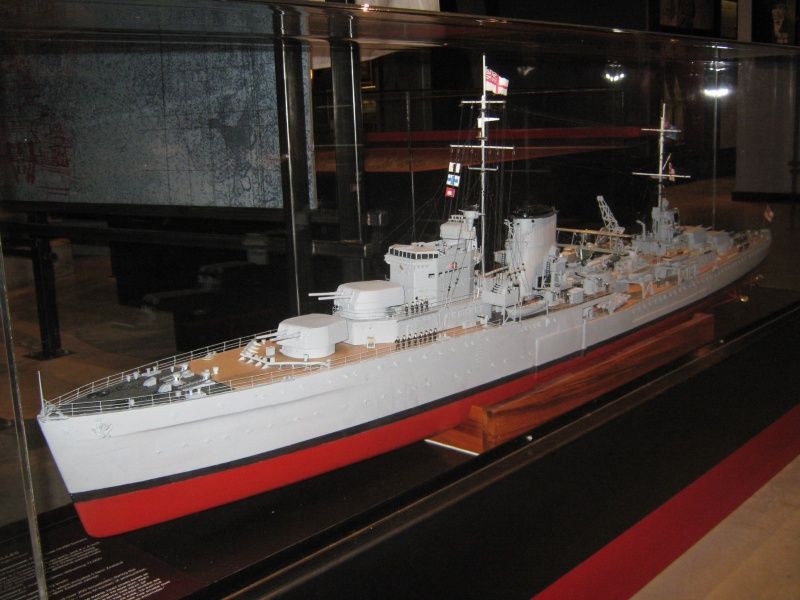 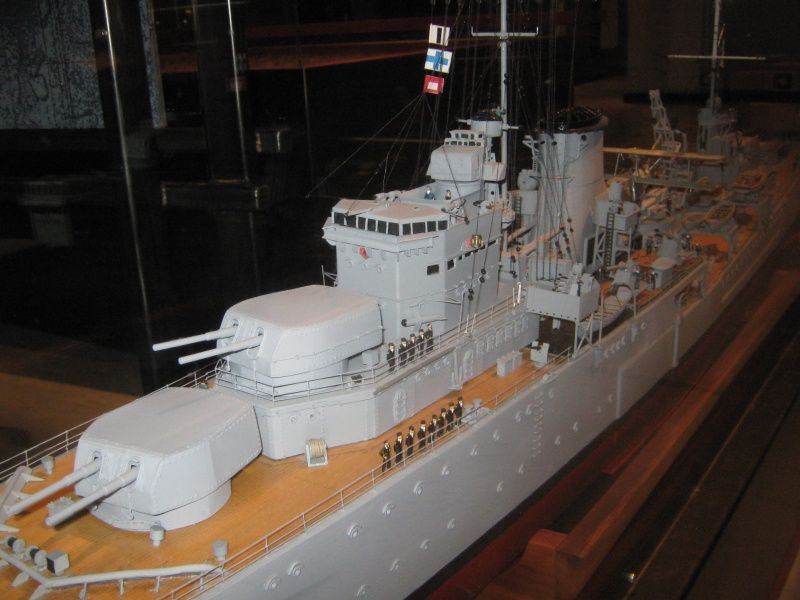 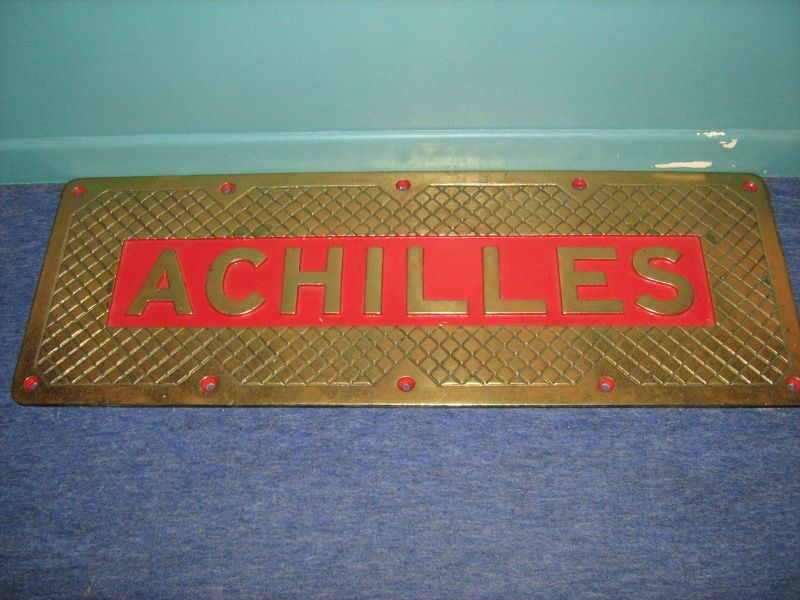 Arguably one of the New Zealand navy's finest hours, the Battle of the River Plate saw a concentrated effort by the three cruisers Achilles, Ajax and Exeter in pursuing and attacking the commerce raider. Although her captain chose to scuttle the vessel after internment at Montevideo harbour, Uruguay, its attackers did manage to mortally wound it in the gun fight that ensued. A much published image of the ship on fire out in Montevideo harbour:  The telegram that was sent from HMS Ajax' Fairey Sea Fox reconnaissance aircraft reporting that the "Graf Spee has blown herself up." 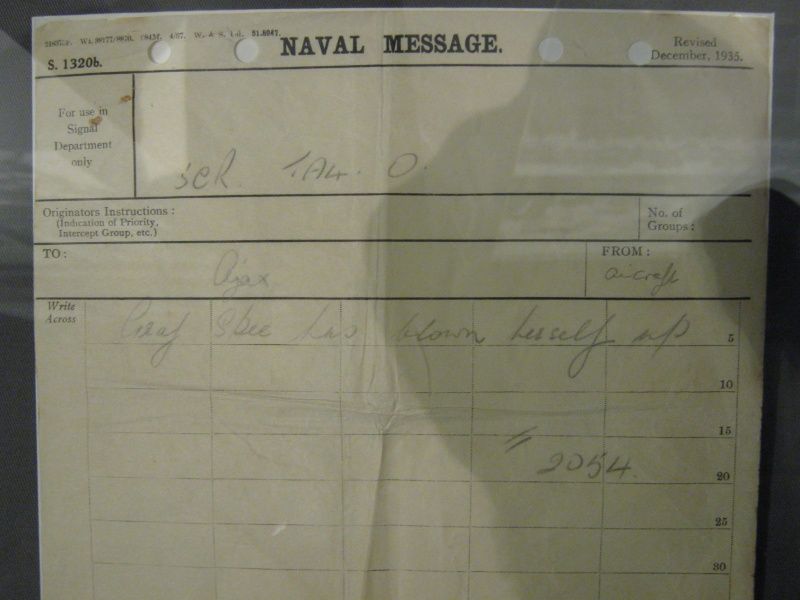 Causing considerable alarm on the launching of KMS Deutschland, the first of the class of three Pocket battleships, as they were nicknamed by the British, the ships of the class of Armoured Ship, or Panzerschiffe to comply with the wording of the Treaty of Versailles, were powerful symbols of the rebirth of the German navy under the Nazis. Commissioned in 1936, the Admiral Graf Spee, the vessel's full name after the Admiral Maximilian Graf von Spee of the German WW1 Far Eastern Squadron, alhough it's almost always abbreviated to 'Graf Spee' was armed with six 28 cm guns in two turrets and was constructed as a commerce raider, allegedly within the size limitations laid down by the Versailles Treaty, although in reality it was much heavier than formally advertised. Powerfully armed for a ship his size (German capital vessels are always male, not female), it was said that he could outgun any vessel that could outrun him (doesn't sound right, does it) and outrun any vessel that could outgun it. Deutschland was renamed Lutzow after the Admiral Graf Spee was scuttled and was eventually scuttled itself at Swinemunde after being damaged by a Tall Boy bomb in May 1945. Admiral Scheer had an admirable war record, at 137, 223 tons sunk, it sank the greatest tonnage of enemy vessels of all German warships during WW2. Itself was sunk by Tall Boys in April 1945 at Kiel, the remains being buried under a new quay post war. 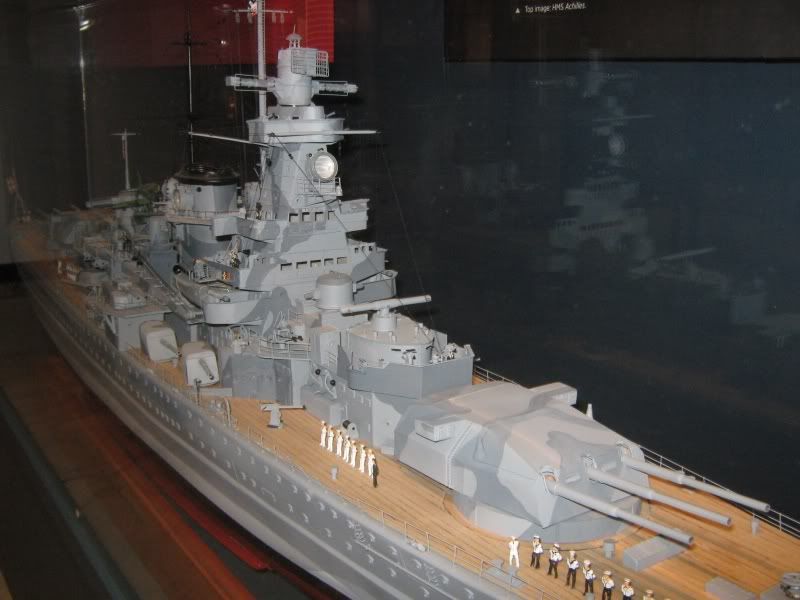 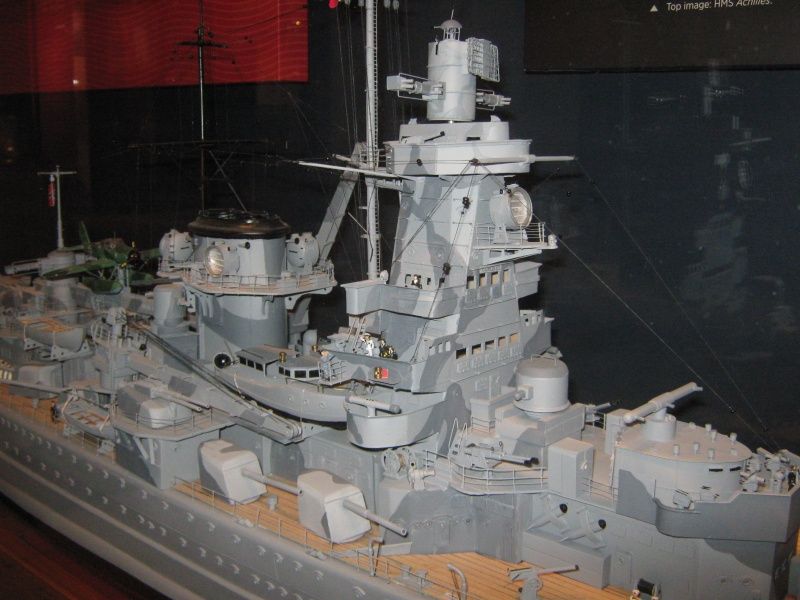 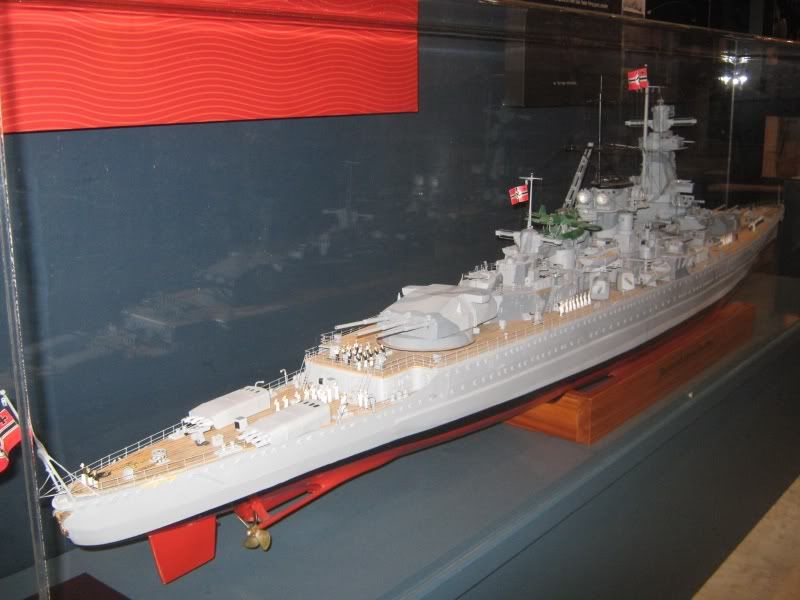 A collection of aircraft recognition models of Japanese types as indicated on the mounting stand, with a device for gauging the distance and appearance of aircraft from different angles by looking through the hole in the base at left, behind. The types on the stand at front are as follows; Judy; Yokosuka D4Y dive bomber, Betty; Mitsubishi G4M torpedo carrier and bomber, Irving; Nakajima J1N1 night fighter, Sally; Mitsubishi Ki-21 heavy bomber, Helen; Nakajima Ki-49 heavy bomber, Frances; Yokosuka P1Y1 night fighter, Kawasaki Ki-61 fighter interceptor. 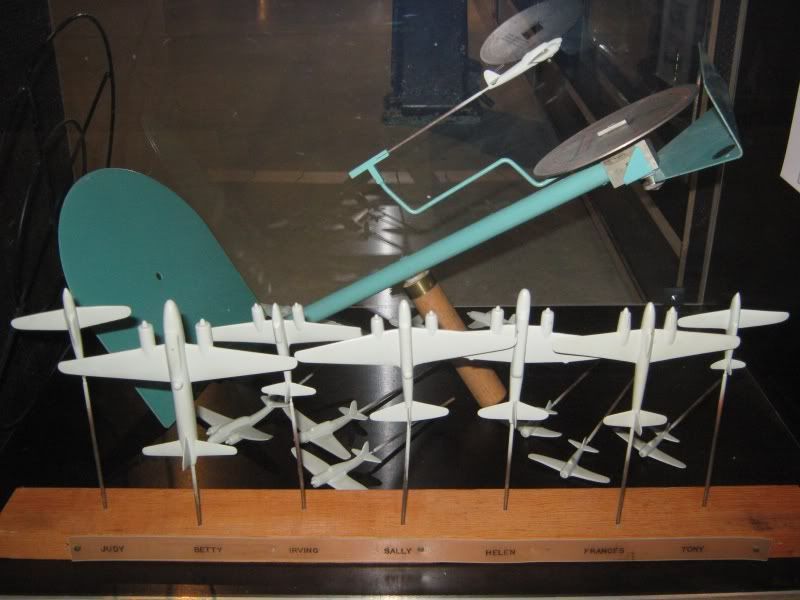 On the night of 29 January 1943 the japanese submarine I.1 was engaged off the north west tip of Guadalcanal by two New Zealand naval vessels, the Bird Class trawlers HMNZS Moa and Kiwi. Despite the Japanese vessel being larger and more heavily armed than the two surface ships, a tussle ensued when the Kiwi picked up an asdic signature and began dropping depth charges. After three attacks by the Kiwi on the contact, the Japanese sub rose to the surface and the ships then began to fire at the damaged submarine. During the fire fight, the submarine's five inch deck gun opening up at the two vessels, the Kiwi rammed the big sub no less than three times, its crew continuously spraying the sub's deck with gun fire at point blank range, but the submarine was able to pull away from the plucky little vessel, which withdrew owing to its guns being too hot to continue firing. Then, the Moa began to fire on the fleeing submarine before it ran aground on a reef; the Moa standing off the stricken sub until morning. In 1968, the frigate HMNZS Otago retrieved the submarine's 5-inch gun and it is now on display in the museum.  Here it can be seen outside the Spring Street museum, in company with a Limbo anti-submarine mortar. 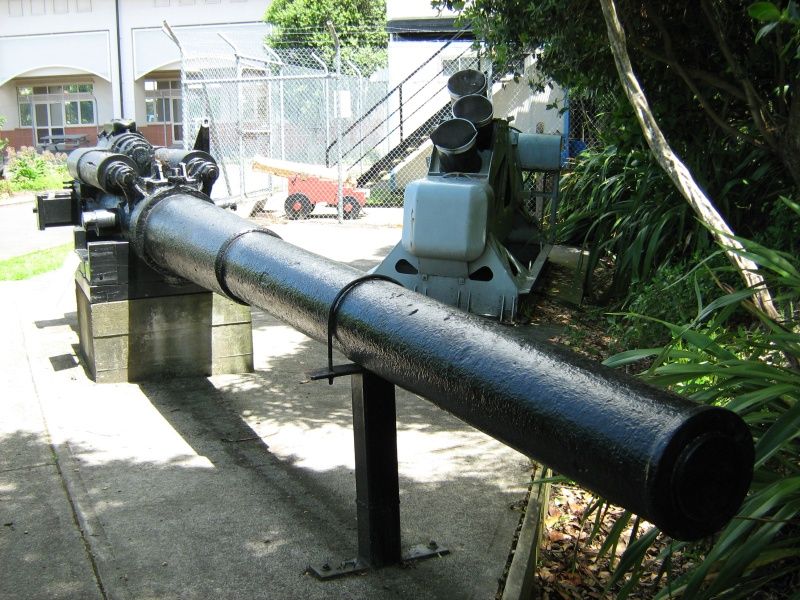 More soon. |
|
|
|
Post by Dave Homewood on Jun 23, 2014 1:15:11 GMT 12
|
|
|
|
Post by Dave Homewood on Jun 23, 2014 1:18:42 GMT 12
|
|
|
|
Post by nuuumannn on Jun 23, 2014 1:21:45 GMT 12
Good stuff, Dave. I've got more coming, but am taking a break for now. I noticed the ship's shield of HMNZS Tutira; one of her guns survives on the Devonport foreshore. I'll post a pic tomorrow.
it was Kiwi and Moa that sank I.1, not Tui, Dave.
|
|
|
|
Post by Dave Homewood on Jun 23, 2014 9:32:36 GMT 12
I knew it was Kiwi and Moa. I have no idea why I ended up typing Tui - not even sure if that was a boat. It was obviously too late and my fly addled head was playing tricks.
|
|
|
|
Post by nuuumannn on Jun 23, 2014 13:07:23 GMT 12
No worries Dave, it was two o'clock in the morning.  Tui was Kiwi and Moa's sister. Continuing a tradition of New Zealand based cruisers that went back to the Philomel, three examples of the (Improved) Dido Class anti-aircraft cruisers were commissioned into the RNZN post war. These were the ships HMS Bellona, Black Prince and Royalist, which retained their names whilst in RNZN service. HMS Black Prince, depicted below was built by the Fairfield ship builders at Govan, Glasgow and was commissioned on Trafalgar Day 1943. She had a distinguished career during WW2, escorting convoys to Russia and operations off the Normandy coast in support of Overlord. Serving as one of the British Pacific Fleet, she bombarded the Japanese coast off Tokyo in 1945 and was present at the official Japanese surrender in Tokyo Bay in September that year. By the time she joined the RNZN she was classified as obsolete and was facing an expensive refit and although her sister Royalist received this, she became an orphan as the only one of her class to do so and Black Prince retained her original configuration throughout her career. In New Zealand service Black Prince escorted the Royal Tour for the vessel Gothic in 1953/1954 but lasted only another year in service, being paid off in July 1955. 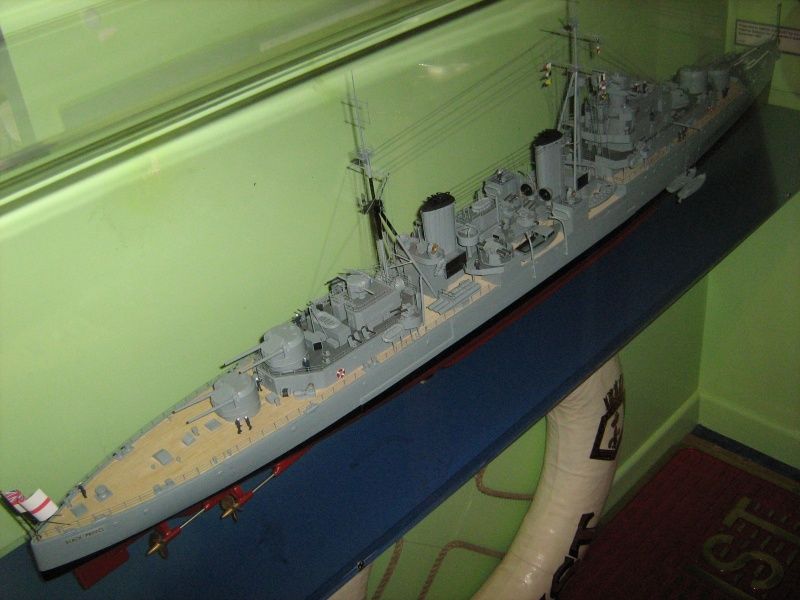 Ordered for replacement of the Loch Class frigates in 1957, the Type 12 frigates Otago and Taranaki were represented the beginning of the 'modern' RNZN and the end of the Cruiser era. Originally designated Whitby Class frigates, the two ships were renamed as Modified Type 12 Rothesay Class anti-submarine vessels and were armed with a twin 4.5-inch gun turret, Limbo anti-submarine depth charge thrower, 21-inch torpedo launchers, assorted light guns and later a Sea Cat surface to air missile launcher. The last of the class to serve with the RNZN was HMS Blackpool, which was sent as an interim until the arrival of the Type 12 Leander Class frigate HMNZS Canterbury. 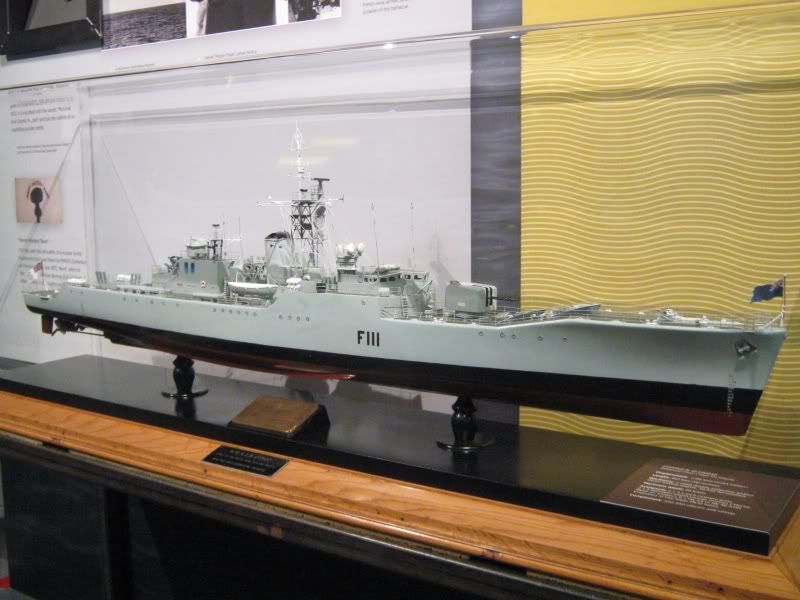 HMNZS Otago took part in regular deployments around the world, including ther United States, where at Pearl Harbour her bow was damaged when berthing between two US Navy destroyers in 1964. Controversially, she was sent to protest French atmospheric testing of nuclear weapons at Mururoa Atoll in 1973. Her guns were fired in practise at another vessel with the intent of sinking it, the dredge Paritutu off Cuvier Island along with the Loch Class frigates Pukaki and Rotoiti. Otago was scrapped in 1987 and one of her propellers is on display outside the North Shore yacht Club. 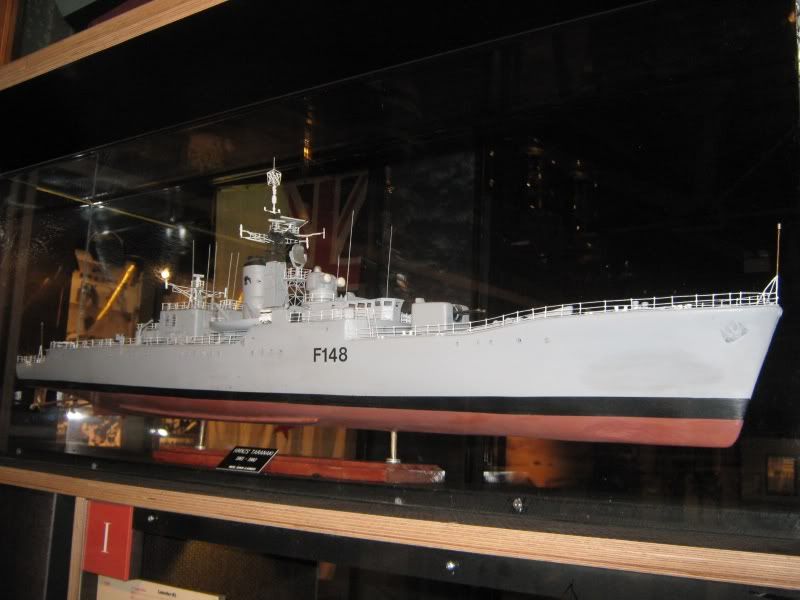 HMNZS Taranaki had a mixed career with the RNZN, being laid up for a year in 1977 to 1978 owing to personnel shortages within the navy. She also suffered a fire in Hong Kong and a prop shaft fault whilst in Fiji in 1981, both times she had to return to Auckland for repair. She became a training vessel from 1978 and had her Sea Cat and Limbo removed and was scheduled for conversion to gas turbine powerplant installation, but this was cancelled when in 1981 the navy purchased the Leander Class frigate HMS Bacchante, which became HMNZS Wellington. Taranaki was scrapped in Auckland in 1983. An example of the standard NATO ship and air launched torpedo, the US built Mk.46 light weight anti-submarine torpedo, which was employed aboard New Zealand frigates from the Leanders on. Designed at the Naval Ordnance Test Station at Pasadena and constructed by Aerojet, the Mk.46 entered service in 1979 and is launched from Mark 32 Surface Vessel triple tube deck lanucher or can be carried aloft by ASW helicopter. Propelled by a two-speed external combustion engine, the Mk.46 has a 99 lb (44 kg) warhead of PBXN-103 High Explosive and has active acoustic or passive homing, with a range of 12,000 yards (nearly 11,000 m).  This mine was one of a number that were strung as harbour defence measures around the Waitemata Harbour during WW2 and is on display on the Devonport foreshore. 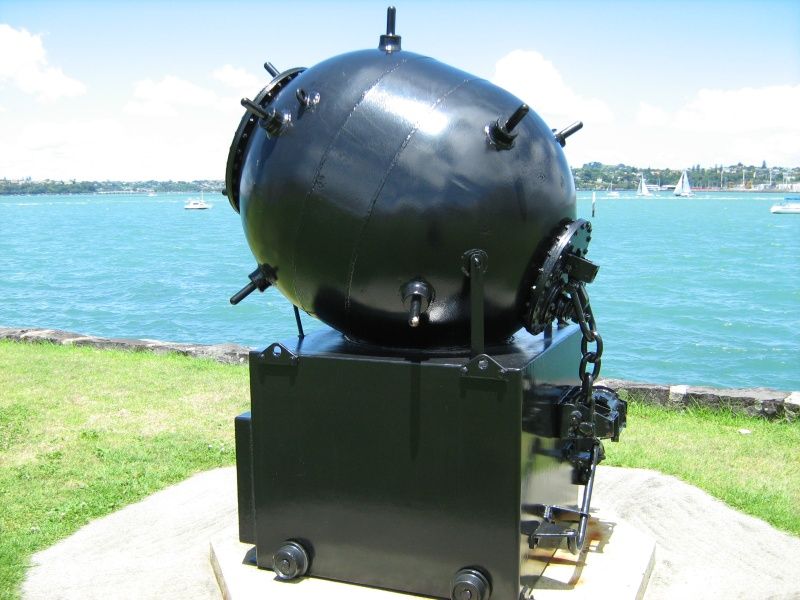 Also mounted on the Devonport foreshore is this 3 pdr Hotchkiss gun from the Loch Class frigate HMNZS Tutira. 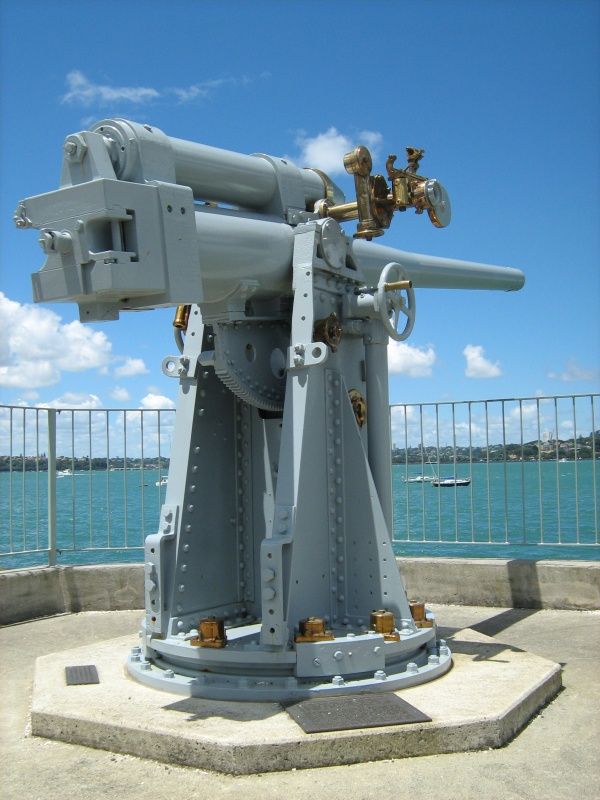 Finally, one of HMNZS Achilles six-inch gun turrets, along with gun director can be seen just inside the main entrance to the Devonport naval base. A kind word to the fellow on guard duty at the gate will get you on the other side of the fence and closer to the turret. 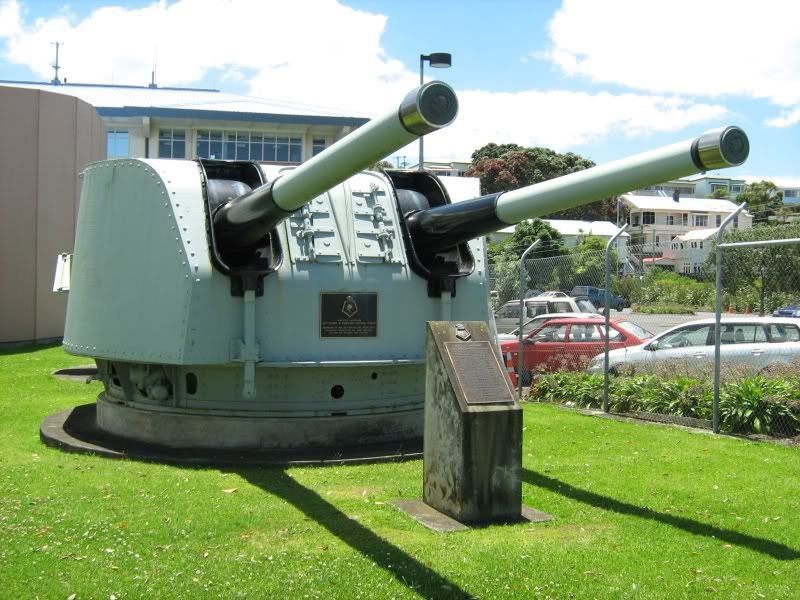 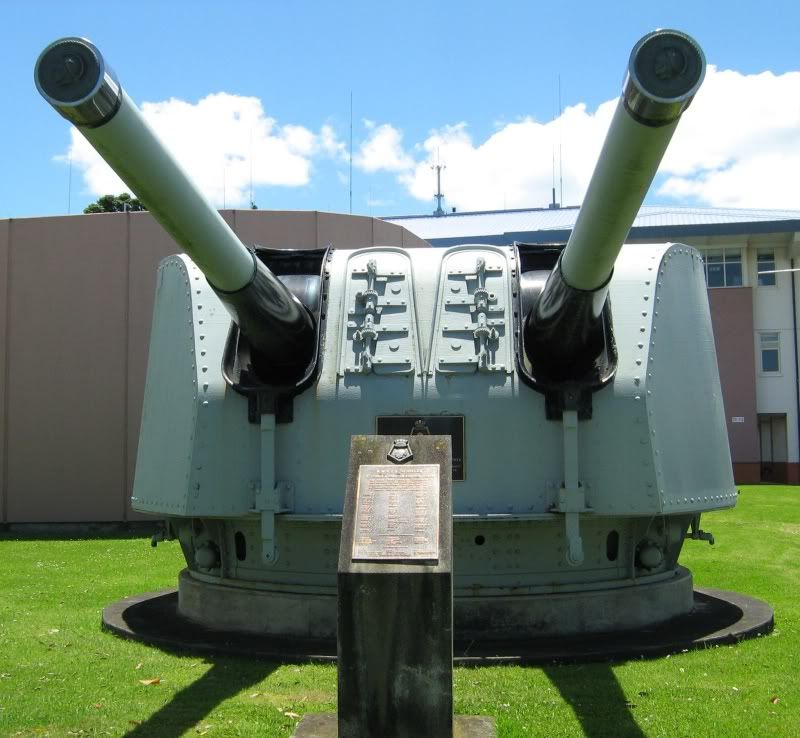 . Thanks for looking.  |
|
|
|
Post by davidd on Jun 23, 2014 14:28:45 GMT 12
Great set of photos, and much good info on "our" ships, etc, Grant. One minor point is that the Torpedo Boat Museum in Lyttelton is not actually in the inner harbour at all, but around the corner to the south, although you can walk down a track from the main road above, or go around the shore way from the Lyttelton side and into the pretty little inlet called Magazine Bay (because that was what this building was originally used for!), although the Bay was also the site of the original base for one of the Thornycrofts. This is well worth a visit, although it may be necessary to arrange the visit as it is not open during normal hours (at least it wasn't when I visited about 8 - 10 years ago with other boys and girls from the RNZAF Museum). Main interest is the stern section of the Lyttelton vessel, recovered from Purau foreshore (across other side of harbour) and the thickness of the steel skin has to be seen to be believed - it is incredibly thin! And the photographs on display certainly hint that this was NOT a vessel any sensible person should volunteer to serve in - it would be swamped by any small passing wave, although they were about 70 feet long from memory. Also displayed is a genuine steam engine from one of the Thornycrofts (the Otago one I believe - a very tiny 4 cylinder one (or was it a double compound or some such?), supplied with pressurised steam from a locomotive-type horizontal (coal-fired?) boiler. Definitely a suicide craft in anyone's language. But operated by admirable and stout fellows I would have thought.
David D
|
|
|
|
Post by nuuumannn on Jun 23, 2014 15:44:11 GMT 12
Good info Dave, Yes, although I've not been to the museum, I know where it is. It was shut the times I went down to visit. Would like to do so some time. I've read generally negative comments on the spar torpedo boats, for example, when fitted with Whitehead torpedoes, the boats were very unstable, to the point that accurate aiming and firing of the torpedo was impossible!
Actually, I've just thought of asomething I meant to have said about HMS New Zealand, during the Battle of Jutland, after Beatty's flag ship the Lion was badly damaged, he transferred his flag to New Zealand for the remainder of the battle.
|
|
|
|
Post by pjw4118 on Aug 23, 2014 13:45:43 GMT 12
Nice posting.
Some one asked me the other day if the FAA display at MOTAT was going to be moved across to the Navy Museum, I havent heard anything , but it could make sense , but it would be a big step for MOTAT to strip it out considering the work done by the FAA Ass boys over the years. Has anybody else been asked ?
|
|
|
|
Post by Dave Homewood on Aug 23, 2014 14:10:45 GMT 12
My impression is that the Navy Museum simply doesn't have the room for it. And why shift it to a museum that gets so much less foot traffic than where it is. And as you say, the Fleet Air Arm Museum of new Zealand helped to put MOTAT on then road to where they are now, contributing a significant amount of money to the first large hangar. So the way I see it, it's partly their hangar and they should remain in it, not tucked away in a tiny corner of a smaller museum for fewer people to appreciate. It's bad enough they have lost both their aeroplanes
|
|
|
|
Post by raymond on Aug 23, 2014 17:23:06 GMT 12
It's bad enough they have lost both their aeroplanes Both? There was the Swordfish and the other is? |
|
|
|
Post by Dave Homewood on Aug 23, 2014 18:11:03 GMT 12
They had a Wasp there in their care on loan too representing postwar naval aviation, but the Navy Museum has taken that now I believe. Also several of the FAA veterans who were involved with the FAAMNZ told me they'd been promised by MOTAT management that the Avenger would be restored into FAA colours to represent a British Pacific Fleet example. But management changed and so did that plan. So now they have no aeroplanes representing their service.
|
|
|
|
Post by raymond on Aug 23, 2014 18:25:54 GMT 12
Ahh I have seen the Wasp in storage in one of the Navy Supply Sheds, Im surprised that it left MOTAT any one know why?
|
|
|
|
Post by Peter Lewis on Aug 23, 2014 20:44:51 GMT 12
The Wasp NZ3902 was there at MoTAT two years ago - photo dated 18Aug2011 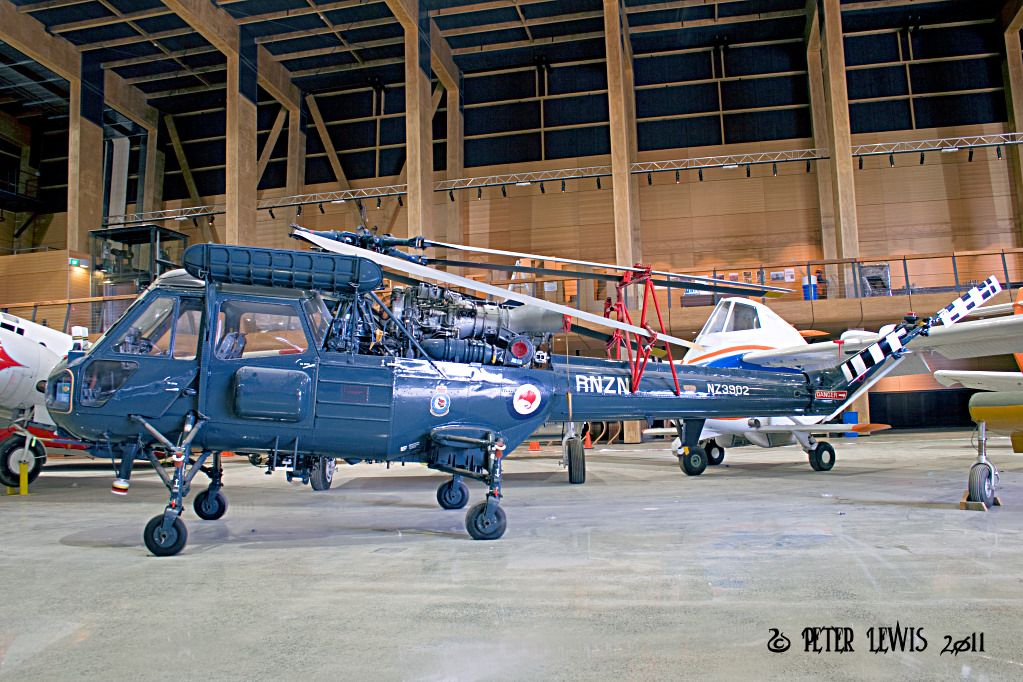 |
|
|
|
Post by camtech on Aug 23, 2014 21:22:39 GMT 12
Wasp NZ3902 was never donated to Motat or the FAA Assn. it was given to the RNZNavy Museum, who in turned loaned it to Motat because of lack of display space at Devonport. As I understand, the aircraft is now in storage at the RNZN Museum.
|
|
|
|
Post by Dave Homewood on Aug 23, 2014 21:54:11 GMT 12
Exactly, I never thought it belonged to the FAAMNZ, but they had two aeroplanes in their display with the promise of a third, and now they have none.
|
|
|
|
Post by kiwithrottlejockey on Oct 29, 2014 19:30:40 GMT 12
First broadcast last Sunday, 26th October 2014, and repeated earlier this evening (I missed it on Sunday, but caught up with it while driving a train to Masterton this evening), Radio New Zealand's Spectrum looks at the history of Devonport's Torpedo Bay Naval Base, including the latest developments at the Navy Museum.... • MEN, MINES, and MARITIME MUSEUMSYou can listen to this fascinating programme (23 minutes, 32 seconds duration) directly from the Radio New Zealand webpage the above link takes you to, or you can download a MP3 file and save it to your computer, smartphone, or other device (also from the same webpage). The webpage also displays some historic photographs of Torpedo Bay. |
|
|
|
Post by delticman on Oct 18, 2017 8:12:54 GMT 12
Did the Torpedo Bay Museum ever had a Sopwith Pup replica at any time?
Pity most of the photos in this thread have gone.
|
|
















































 Tui was Kiwi and Moa's sister.
Tui was Kiwi and Moa's sister.










